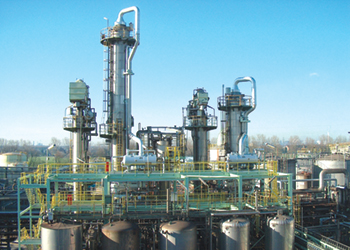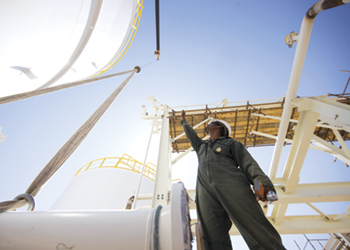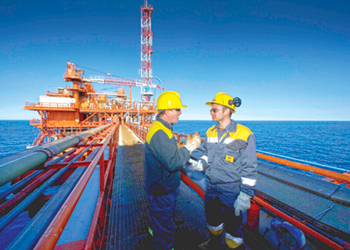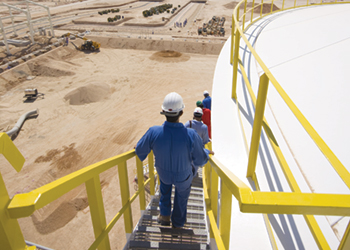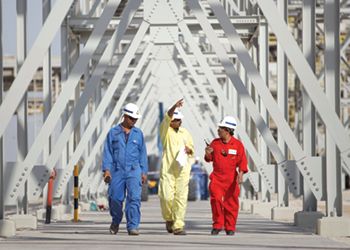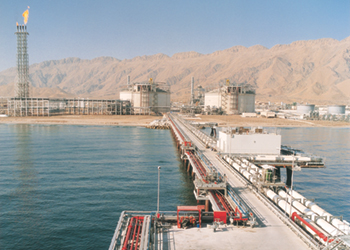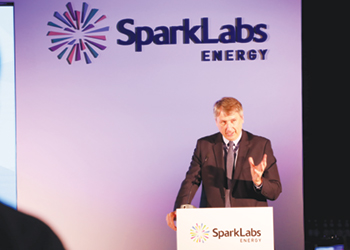
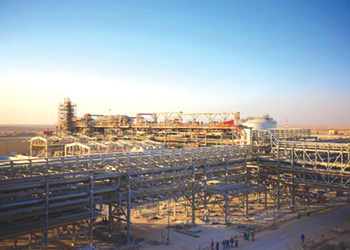 BP’s Khazzan field in Oman
BP’s Khazzan field in Oman
Capitalising on the reversal in its fortunes, the government unveiled plans to hoist liquefaction capacity by more than 1 million tonnes per year (mtpy) to around 11 mtpy, and the ministry says that might increase by another 1 mtpy if more gas is found
In the 18 months since BP’s Khazzan field started up, Oman has gone from gas shortage to surplus—and other major international players have sat up and taken notice.
Existing investors are plowing in more money: Total, for example, increased its footprint when it signed a preliminary exploration deal for Block 12 in the center of the country. At the same time, companies that used to shun Oman in favour of bigger, better-endowed neighbours are having a rethink, drawn by its reputation for being a straightforward place to work.
Gas output last year averaged 4.4 billion cubic feet per day (45.6 billion cubic meters), up from 3.95 bcfd the year before, while gas reserves climbed to 24.65 trillion cubic feet, according to the Ministry of Oil and Gas. Khazzan is now producing 1 bcfd and a second phase, Ghazeer, should add 500 million cubic feet per day. It had been due on line in 2021, but looks set to be earlier.
Capitalising on the reversal in its fortunes, the government unveiled plans in November to hoist liquefaction capacity by more than 1 million tonnes per year (mtpy) to around 11 mtpy, and the ministry says that might increase by another 1 mtpy if more gas is found.
Newer entrants to the country include Italy’s Eni, which picked up the giant offshore Block 52 in an upstream tender in 2016 and 85 per cent of Block 47 in a tender last year. Longtime Omani player Occidental has signed three new licenses for Blocks 51, 65, and 72 in the past 18 months that have boosted its gross acreage by 2.3 million acres to 6 million acres.
More international firms could enter in the latest licensing round. Six concessions are up for grabs -- 58, 70, 73, 74, 75 and 76 -- which form part of majority state-owned Petroleum Development Oman’s (PDO) prolific Block 6, which produces most of the country’s 990,000 barrels per day of oil.
Outside the formal tender process, Eni and BP—which is on the hunt for more up- and downstream opportunities—signed a heads of agreement for Block 77, in the center of the country, earlier this year. The two hope to finalise a production-sharing agreement (PSA) for the 3,100 square kilometre block soon. Royal Dutch Shell, state-owned Oman Oil Co. (OOC) and Total are also eyeing integrated gas projects.
The aim would be for all three firms to exploit upstream gas resources in the Greater Barik area—Blocks 10 and 11 in the northern part of Block 6. Total and OOC would then build and run a 1 mtpy LNG plant and develop an LNG bunkering hub at Sohar.
Shell and OOC would use their share of the gas to feed what could be Oman’s first gas-to-liquids (GTL) plant, although the plan has still to be finalised amid questions over GTL’s economic feasibility. Shell provided the technology for the world’s first commercial GTL plant, Bintulu in Malaysia, and its biggest, Pearl GTL in Qatar.
Shell already has exposure to Oman through a 30 per cent stake in Oman LNG and 34 per cent of PDO, while Total owns 4 per cent of Block 6 and minor stakes in Oman LNG and Qalhat LNG. The 10,000 sq km Block 12 lies south of the Greater Barik area, and Total plans to drill its first well there in 2020.
Greater Barik includes the Mabrouk North East and Mabrouk West fields, for which Shell and Total are expected to sign a PSA with PDO later this year. PDO announced the discovery a year ago, and Mabrouk is estimated to hold 4.4 tcf of recoverable gas reserves and 112 million barrels of condensate.
PDO’s Rabab Harweel integrated project is expected to start up in early June, three months ahead of schedule. It is pegged to produce around 210 mmcfd of sweet gas and 76,000 bpd of condensate at plateau production, PDO CEO Raoul Restucci says. First gas from PDO’s Yibal Khuff sour gas project is expected in March 2021 and first oil a month earlier. It is now 78 per cent complete.



















































































